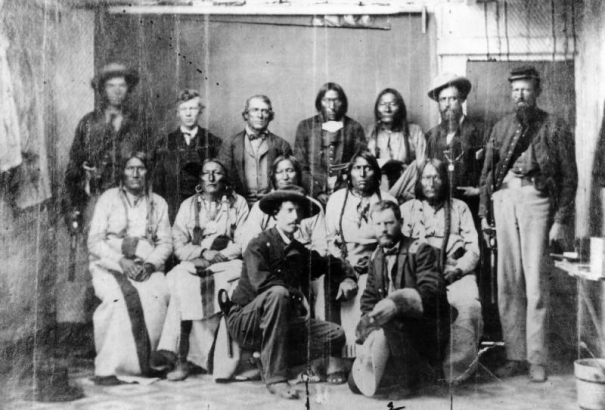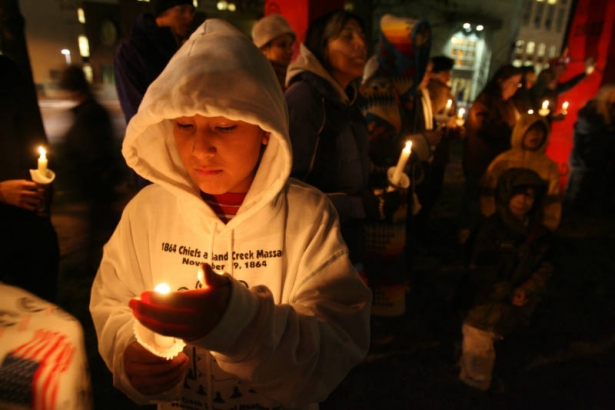[Warning: Quotes in this article include derogatory language, in accordance with the racism of the time and the original writers.]
William N. Byers has been celebrated as one of Denver’s earliest and more vociferous boosters. He ran Denver’s first newspaper, the Rocky Mountain News, from 1859 to 1878 and served as its first owner and editor during that period. His promotion of the area’s agricultural and economic benefits, some of which were questionable or downright lies, helped enrich the city, state, and Byers himself. However, as they say, with great power comes great responsibility, and Byers used his power in ways that caused harm to many of Colorado’s residents of color, particularly local Cheyenne and Arapaho people.
Byers’s greatest harm was centered around the Sand Creek massacre in late 1864. A strong supporter of Governor John Evans, Byers helped to promote the concept of an “Indian War” being waged at that time and further perpetuated this myth in his 1901 volume, Encyclopedia of Biography of Colorado. Indeed, violence was perpetrated by Native Americans and white settlers, but to call it a full-scale war was excessive by most standards. Through 1864, the Rocky Mountain News was full of “Indian raids,” reports of those killed by Native American attackers, and a barely averted plan to massacre settlers to the south and all along the Platte (Aug. 26, 1864). White panic flourished when the Hungate family was murdered and mutilated just outside of Denver in June. The rhetoric of newspapers in the region, including the Rocky Mountain News, only served to further excuse violence against all nearby Native Americans, as would be seen.
In August, the Rocky Mountain News published an appeal by Governor Evans to establish civilian militias to fight “the merciless savages.” To back that up, the News published its own editorial, written or at least approved by Byers, that encouraged citizens to join. The editorial declared, “A few months of active extermination against the red devils will bring quiet, and nothing else will.” (Aug. 10, 1864). Three days later, they again published an appeal from the Governor, this one specifically for volunteers to join the Third Regiment. On October 5, the Rocky Mountain News published under the headline “Good News for the Third Regiment,” a message from Colonel Chivington that “The boys of the Third may soon be off on the war path [sic]. Let the red skins [sic] look out now.”
Controversies over blame and cruelty surround the history of the Sand Creek Massacre. Regardless, on November 29, 1864, First and Third Regiment cavalry attacked the village of Cheyenne and Arapaho people under the leadership of Black Kettle, a Cheyenne chief trying to maintain peace. There are accounts that Black Kettle was waving an American flag and/or a white flag at the time of the attack. In spite of all indications that the village was peaceful, US troops killed approximately 200 of the men, women, and children as they tried to flee. The volunteers then mutilated their corpses and took gruesome trophies of their kills.
In the aftermath of the Sand Creek Massacre on November 29, 1864, the Rocky Mountain News trumpeted it as a “Great Battle with Indians,” and celebrated the deaths of Native Americans (Dec. 14, 1864). Even after multiple federal jurisdictions investigated the incident and declared Sand Creek a “foul and dastardly massacre,” Byers’s paper continued to stand by Chivington and Governor Evans, endorsing and publishing their counter-arguments and endorsing the “Sand Creek Vindication Ticket” that November.
Byers continued to endorse this false narrative of Sand Creek years later. An 1870 column expressly written by the News’s editor--Byers--argued that “our soldiers should not be blamed for killing women and children in their onslaughts upon Indian camps.” As an example, he described, “at Sand Creek our men were wounded and killed by arrows shot by tender aged boys--and, Heaven save the mark--tender squaws” (RMN Apr. 13, 1870). He had not changed his story by 1901, again claiming that the investigations were intentionally biased against Chivington and “ignored all testimony as to the immediate culpability of the Indians slaughtered, as revealed by the numerous scalps and piles of plunder found in their possession” (Encyclopedia of Biography of Colorado).
While Byers’s words may seem less significant as we now acknowledge the horror of the Sand Creek massacre, it is worth noting several specific elements of harm that his words did. In contributing to an environment that would allow for such a massacre, Byers contributed to the generational trauma experienced by the massacre’s survivors and their descendants. By denying the reality of what happened, he continued to twist that knife and contributed to the cover-up of indigenous memory for ensuing generations.

![[William N. Byers] [art original].](/sites/history/files/styles/blog_image/public/cdm_85720.jpg?itok=6FAV8zVv)


Comments
Who was Byers intended
Who was Byers intended audience considering the Sand Massacre?
Thanks for reading and asking
Thanks for reading and asking, Axel. The Rocky Mountain News was mainly published for and read by the settlers of Denver.
I applaud the name change of
I applaud the name change of the public library branch in honor of Chief Little Raven and his descendants and all Native Americans who have suffered from the effects of brutal efforts at extermination.
Thanks for reading and
Thanks for reading and responding, Ruth. Renaming buildings is a small but worthwhile step toward addressing the harm we have done.
As some commenters have
As some commenters have already said it would be helpful to contextualize the name change for everyone and explain on site in a permanent installation. 1. Why and when the library was named Byers originally and 2. Why it was changed. It’s is not enough to remove the name preventing future generations from benefiting from contextual understanding of history and our contemporary perspectives. There must be a responsible and sensitive way to explain it all so we can continue to have conversations about difficult subjects.
Thank you for this thoughtful
Thank you for this thoughtful suggestion, Sally. I'm going to send it to my colleagues at the branch and in our communications department to see what we can do.
We should not pretend that
We should not pretend that the people of that time were ignorant. In fact, research into congressional hearings from 1872 demonstrates the opposite. Byers recruited staff members to participate in the massacre. He was NOT innocent of pervasive racism and invoking hostile sentiments against the owners of the land. One fact everyone fails to recognize , Indians legally owned the land and were simply defending it against a hoard of invaders. What would you have done if these intruders tried to take your land. Think about The Russian invasion of Ukraine. That is exactly what happened to Native people in Colorado.
Add new comment